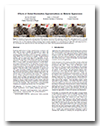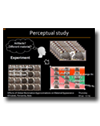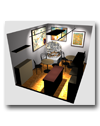 |
Jaroslav Křivánek |
Effects of Global Illumination Approximations on Material Appearance
|
Jaroslav Křivánek
Cornell University & Charles University, Prague |
James A. Ferwerda
Rochester Institute of Technology |
Kavita Bala
Cornell University |

Examples of inequivalent and equivalent VPL rendering. (a)-(b) are VPL renderings with 1k VPLs, and clamp levels C1 = 316 and C8 = 0.1, respectively, that are not equivalent to the reference (d) because they have image artifacts (a) or different perceived material appearance (b). (c) VPL rendering produces an image that is visually equivalent (≡) to the reference for 100k VPLs and clamp level C4 = 10, even though some reflections are lost where the Dragon is in contact with the pedestal and around its silhouette.
Abstract
Rendering applications in design, manufacturing, ecommerce and other fields are used to simulate the appearance of objects and scenes. Fidelity with respect to appearance is often critical, and calculating global illumination (GI) is an important contributor to image fidelity; but it is expensive to compute. GI approximation methods, such as virtual point light (VPL) algorithms, are efficient, but they can induce image artifacts and distortions of object appearance. In this paper we systematically study the perceptual effects on image quality and material appearance of global illumination approximations made by VPL algorithms. In a series of psychophysical experiments we investigate the relationships between rendering parameters, object properties and image fidelity in a VPL renderer. Using the results of these experiments we analyze how VPL counts and energy clamping levels affect the visibility of image artifacts and distortions of material appearance, and show how object geometry and material properties modulate these effects. We find the ranges of these parameters that produce VPL renderings that are visually equivalent to reference renderings. Further we identify classes of shapes and materials that cannot be accurately rendered using VPL methods with limited resources. Using these findings we propose simple heuristics to guide visually equivalent and efficient rendering, and present a method for correcting energy losses in VPL renderings. This work provides a strong perceptual foundation for a popular and efficient class of GI algorithms.
Publication & Presentation
Jaroslav Křivánek, James A. Ferwerda, and Kavita Bala. Effects of Global Illumination Approximations on Material Appearance.
ACM Trans. Graph. 29, 4 (2010) ... BibTeX
Downloads
| paper |
supplementary document |
presentation slides |
fast forward slides |
stimulus scene* |
 |
 |
 |
 |
 |
| 26MB pdf | 1.8MB pdf | 15MB pdf | 0.7MB pdf | 20MB pptx | 5MB pdf | 5.7MB ppt | 0.9MB pdf | 42MB zip |
(*) This 3ds max scene served as a basis for creating the stimulus images. We exported the scene, modified the materials, and rendered the stimulus images with a custom-built renderer.
Stimulus Images
Click on an image for the corresponding VPL count vs. clamping level table.
Main Study
|
|























































